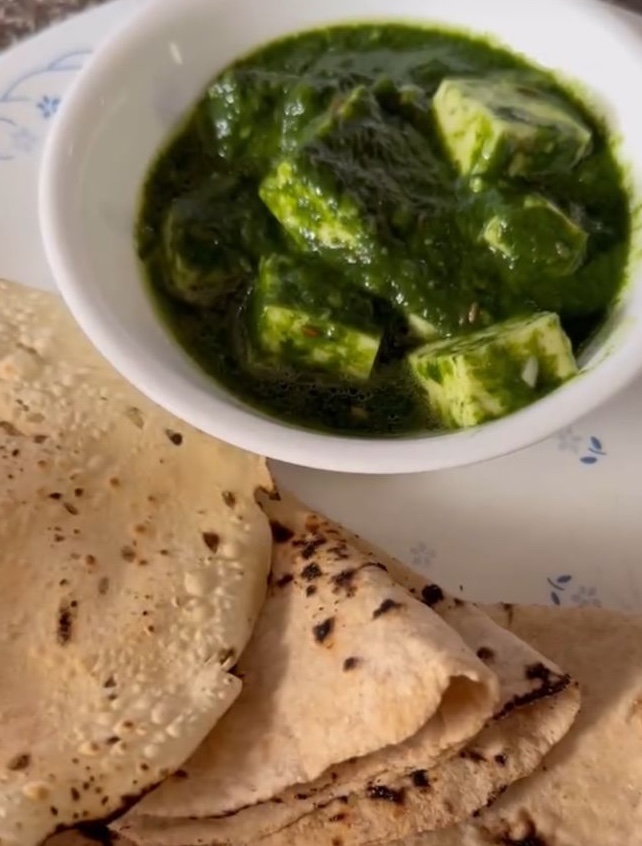The Origins, Pairings, and Nutritional Value of Palak Paneer!
Palak Paneer, a classic North Indian dish, is a staple in Indian households and a popular choice in Indian restaurants worldwide. This vibrant green curry, made with spinach (palak) and paneer (Indian cottage cheese), combines creamy textures with a burst of flavors, making it both comforting and nourishing. It is celebrated for its simplicity, health benefits, and versatility.
Whether paired with naan, roti, paratha, or rice, Palak Paneer is a dish that never fails to please. In this article, we delve into the origins of Palak Paneer, the various ways it can be enjoyed, and why it is a favorite for those seeking a balance of taste and nutrition.
The Origins of Palak Paneer
Palak Paneer has its roots in North India, where spinach and paneer are integral components of traditional cuisine. Paneer, a type of fresh cheese, has been used in Indian cooking for centuries, thanks to its neutral flavor and versatility. Spinach, a nutrient-dense leafy green, is also widely cultivated and consumed in the region. Together, they form a dish that is not only delicious but also deeply connected to the agricultural and culinary traditions of India.
The dish likely originated in Punjab, a region known for its rich, hearty, and dairy-centric cuisine. Palak Paneer exemplifies the Punjabi love for robust flavors and creamy textures, while also reflecting the use of fresh, local ingredients. Over time, Palak Paneer has transcended regional boundaries and gained popularity across India and beyond.
Why Palak Paneer is So Popular
Palak Paneer’s popularity can be attributed to its unique combination of flavors, textures, and health benefits. The earthy taste of spinach pairs beautifully with the mild, creamy paneer, creating a dish that is rich and satisfying yet not overly heavy. The spices used in Palak Paneer enhance the natural flavors of the ingredients without overpowering them, making it a well-balanced and versatile dish.
Another reason for its widespread appeal is its adaptability. Palak Paneer can be enjoyed in a variety of settings, from casual weeknight dinners to elaborate festive meals. It is also easy to prepare, requiring just a handful of fresh ingredients and a simple cooking process.
Pairing Palak Paneer with Rice, Breads, and More
One of the best things about Palak Paneer is its versatility when it comes to pairings. It can be served with a variety of accompaniments, making it suitable for different occasions and preferences.
- With Rice: Palak Paneer pairs wonderfully with steamed basmati rice, which provides a light, fragrant base that allows the flavors of the curry to shine. For an elevated experience, try pairing it with jeera rice (cumin-flavored rice), which adds a subtle aromatic layer to the meal. The combination of spinach, paneer, and rice creates a wholesome, comforting dish that is both satisfying and easy to digest.
- With Naan: Naan, a soft and pillowy leavened bread, is one of the most popular accompaniments to Palak Paneer. The bread’s slightly chewy texture complements the creamy curry, and its mild flavor enhances the overall taste of the dish. Garlic naan, in particular, adds an extra layer of flavor, making each bite even more indulgent.
- With Roti or Paratha: Roti, a whole wheat flatbread, is a healthier option that pairs perfectly with Palak Paneer. Its simplicity allows the rich flavors of the curry to take center stage. Paratha, a layered and slightly buttery flatbread, is another excellent choice. The flaky texture of paratha contrasts beautifully with the smooth spinach gravy.
- With Quinoa or Couscous: For a modern twist, Palak Paneer can be served with quinoa or couscous. These gluten-free alternatives provide a nutty flavor and a boost of nutrients, making the dish even healthier. This pairing is perfect for those looking to incorporate more variety into their meals.
- As a Filling or Topping: Palak Paneer can also be used as a filling for wraps or as a topping for baked dishes like lasagna. Its creamy texture and rich flavors make it a versatile component in fusion recipes.
Nutritional Benefits of Palak Paneer
Palak Paneer is not just delicious—it’s also packed with essential nutrients, making it a great choice for health-conscious individuals. Here are some of the key nutritional benefits of this dish:
- Rich in Protein: Paneer is an excellent source of protein, making Palak Paneer a great option for vegetarians looking to meet their daily protein needs. Protein is essential for muscle repair, growth, and overall health.
- High in Vitamins and Minerals: Spinach is a powerhouse of vitamins and minerals, including vitamins A, C, and K, as well as iron, calcium, and magnesium. These nutrients play a crucial role in maintaining bone health, supporting the immune system, and improving overall energy levels.
- Low in Carbohydrates: Palak Paneer is naturally low in carbohydrates, making it a suitable option for those following low-carb or ketogenic diets. When paired with a low-carb side like cauliflower rice, it becomes an even healthier meal.
- Rich in Antioxidants: Both spinach and the spices used in Palak Paneer, such as turmeric and cumin, are rich in antioxidants. These compounds help protect the body from oxidative stress and reduce inflammation, promoting overall health.
- Good Source of Calcium: Paneer is rich in calcium, which is essential for maintaining strong bones and teeth. Spinach also contains calcium, though it is not as easily absorbed due to the presence of oxalates. Together, they contribute to better bone health.
Palak Paneer for All Occasions
Palak Paneer is a versatile dish that can be enjoyed on a variety of occasions, making it a favorite among home cooks and chefs alike.
- Everyday Meals: Palak Paneer is easy to prepare, making it a great choice for weeknight dinners. Its comforting flavors and balanced nutrition make it a satisfying meal for the entire family.
- Festive Feasts: During festive occasions and celebrations, Palak Paneer often features as part of a larger spread, alongside dishes like dal makhani, biryani, and tandoori bread. Its vibrant green color and rich flavors make it a standout dish on any table.
- Special Diets: Palak Paneer can be adapted to suit various dietary preferences. It is naturally vegetarian and can be made vegan by substituting paneer with tofu and cream with cashew or almond paste.
- Meal Prep: Palak Paneer is also great for meal prep, as it reheats well and retains its flavor. Cook a batch over the weekend and pair it with different sides throughout the week for variety.
The Global Appeal of Palak Paneer
While Palak Paneer is deeply rooted in Indian cuisine, its appeal has spread far beyond the country’s borders. It is a favorite dish in Indian restaurants worldwide, often featured alongside other classics like butter chicken and biryani.
Its rich, creamy texture and mild spice level make it approachable for those new to Indian food, while its health benefits appeal to health-conscious diners. In recent years, Palak Paneer has also gained popularity in the vegan and plant-based communities, thanks to its adaptability and nutrient density.
Palak Paneer is more than just a dish—it’s a celebration of the simplicity and richness of Indian cuisine. Its origins in North India, combined with its universal appeal and nutritional benefits, make it a favorite for people of all ages and backgrounds. Whether you enjoy it with rice, roti, or naan, Palak Paneer offers a satisfying and flavorful meal that is both comforting and wholesome.
The next time you’re craving something delicious and nutritious, consider making Palak Paneer. With its vibrant flavors, creamy texture, and versatility, it’s a dish that’s sure to become a favorite in your kitchen.






